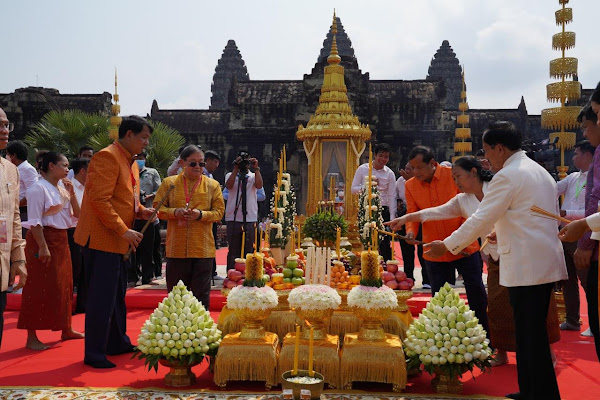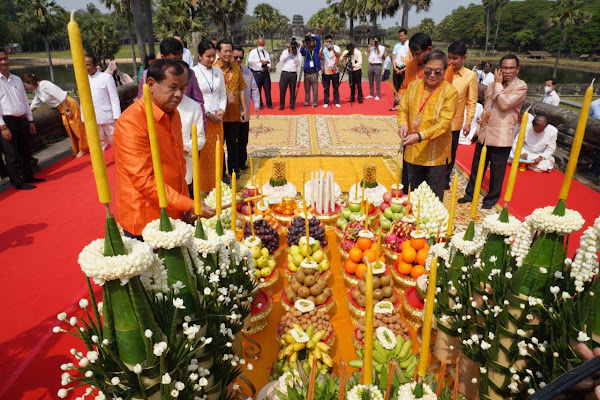ក្នុងពិធីសាសនា នៅប្រទេសកម្ពុជា ដូចជាពិធីបញ្ចុះសីមា ពិធីឡើងផ្ទះ ការសាងសង់អគារថ្មី ការរៀបចំព្រឹត្តិការណ៍សិល្បៈ ឬពិធីរៀបមង្គលការជាដើម គេតែងប្រារព្ធធ្វើ «ពិធីប្រុងពលី ឬក្រុងពាលី»។ គេធ្វើពិធីនេះឡើង ដើម្បីសុំម្ចាស់ទឹកម្ចាស់ដី ដើម្បីឱ្យគម្រោង ព្រឹត្តិការណ៍ និងកម្មវិធីដែលរៀបចំ ប្រព្រឹត្តទៅដោយសុខសប្បាយ ជោគជ័យ មិនមានឧបសគ្គភ័យន្តរាយណាមួយកើតឡើងឬរារាំងរំខាន។
កាលណានិយាយពាក្យ «ប្រុងពលី ឬក្រុងពាលី» គឺគេសំដៅដល់ពិធីសែនព្រេន បួងសួងដើម្បីសុំសេចក្តីសុខសប្បាយពីម្ចាស់ទឹកម្ចាស់ដី។ ក្រុងពាលី ជាឈ្មោះនៃស្តេចស្វា ជាម្ចាស់ទឹកម្ចាស់ដីដំបូងបង្អស់ ដែលអ្នកធ្វើពិធីនានានៅលើផែនដី ត្រូវសុំការអនុញ្ញាតជាមុន។ ពាក្យថា «ក្រុង» ក្នុងទីនេះ ពុំមានន័យថា «បុរី រដ្ឋ ឬទីប្រជុំជន» ដូចធម្មតានោះទេ តែមានន័យថា «ស្តេច» ដូចជាពាក្យថា «ក្រុងរាពណ៍ ក្រុងអសុរ» ជាដើម។

«ពលី» គឺពលីនាងគង្ហីង ដែលជានិមិត្តរូបនៃដី។ អ្នកដែលគេឧទ្ទិសទៅនោះហៅថា «ក្រុងពាលី»។ តាមន័យទាំងពីរនេះ ឃើញថា «ប្រុងពលី និងក្រុងពាលី» ជាពាក្យដែលមានទំនាក់ទំនងគ្នា ក្នុងពិធីបន់ស្រន់សុំការអនុញ្ញាតធ្វើពិធីផ្សេងៗដូចបានរៀបរាប់ខាងលើ ពីម្ចាស់ទឹកម្ចាស់ដី គឺប្រុងពលី សំដៅដល់ពិធីការ ហើយក្រុងពាលី សំដៅដល់អ្នកទទួលផលពីពិធីការនោះ។ ជារួម កាលណាបើយើងនិយាយពីពិធី គប្បីហៅថា «ពិធីប្រុងពលី» តែបើចង់ប្រើពាក្យថា ក្រុងពាលី គប្បីប្រើថា «ពិធីសែនក្រុងពាលី» ព្រោះពាក្យថា «សែន» ក៏សំដៅដល់សកម្មភាពបូជា ថ្វាយ លះបង់ ដូចនឹងពាក្យថា «ពលី» ជាភាសាបាលីដែរ។ ដោយអាស្រ័យលើជំនឿយ៉ាងខ្លាំងទៅលើស្ដេចក្រុងពាលីនេះហើយ ទើបប្រជាជនខ្មែរគ្រប់ទីកន្លែងរៀបចំពិធីនេះពុំដែលខកខាន។
ដោយឡែក នៅក្នុងរឿង រាមកេរ្តិ៍ ខ្មែរ ពាលី ជាស្តេចស្វាពណ៌បៃតង គ្រងរាជនៅ ខាស់ខិនបុរី ជាព្រះរាជបុត្ររបស់ព្រះនាងកញ្ជនានិងព្រះឥន្ទ្រ ទើបមានស្បែកនិងមុខពណ៌បៃតង។ សាច់រឿងក៏បានបង្ហាញថា ព្រះឥសូរ បានប្តូរឈ្មោះស្តេចស្វានេះទៅជា «ពាលីធិរាជ្យ» ដែលមានន័យថា «អ្នកមានកម្លាំងឫទ្ធីខ្លាំងក្លា» ព្រមទាំងបានឱ្យត្រីសូលមួយទៅពាលីផង។
ពាលី គឺជាស្តេចស្វាមួយដែលមានអំណាចសម្បើមខ្លាំងក្លា។ ដោយមានការប្រទានពរពីព្រះវិស្ណុ ពាលីមានកម្លាំងគ្មានដែនកំណត់ ហើយគ្មាននរណាអាចផ្គូរផ្គងបាន។ តាមការបកស្រាយរបស់ Narayan (១៩៧២) ពីបុរាណកាលមក ទេវតានិងយក្សបានព្យាយាមកូរសមុទ្រដើម្បីយកទឹកអម្រឹត ដោយប្រើភ្នំព្រះសុមេរុជាទម្រ ប៉ុន្តែគេមិនអាចបង្វិលត្បាល់ដែលជាជន្ទល់នោះបាន។ តាមការស្នើសុំពីទេវតា ពាលីបានច្រានអ្នកទាំងអស់ចេញ ហើយបង្វិលត្បាល់នោះរហូតទទួលបានទឹកអម្រឹត ដែលទេវតាបានសោយនិងរួចផុតពីសេចក្តីស្លាប់។
ការសិក្សាតន្ត្រីប្រពៃណីបុរាណខ្មែរ ធ្វើឡើងនៅក្នុងវត្តអារាម សាលារៀន ផ្ទះរបស់គ្រូ ឬគេត្រូវសាងសង់រោងរៀននៅទីណាមួយ។ មុននឹងសង់រោង គេត្រូវធ្វើពិធីសុំទឹកសុំដី និងសែនក្រុងពាលី។ ចំពោះរឿងរ៉ាវក្រុងពាលីនេះ មានច្រើនខុសៗគ្នាទៅតាមការនិយាយតៗគ្នារបស់អ្នកស្រុក។ ខាងក្រោមនេះ ជារឿងពាក់ព័ន្ធនឹងពិធីសែនក្រុងពាលី ដូចតទៅ៖
ប្រភពមួយតំណាលថា កាលពីព្រេងនាយ ថាកាលដែលកទឹកកដីដំបូងនោះ មាននាគពីរជាបងប្អូននឹងគ្នា បងឈ្មោះក្រុងពាលី ប្អូនឈ្មោះព្រះភូមិ ដែលជាអ្នកមានឥទ្ធិឫទ្ធិ បានបង្កើតឱ្យមានមនុស្ស សត្វ ព្រឹក្សាលតាវល្លិ៍គ្រប់បែបយ៉ាង នៅលើផែនដីថ្មីនោះ ហើយក៏តាំងខ្លួនជាម្ចាស់ទឹកម្ចាស់ដីនោះទៅ។ ក្រោយមក មានព្រះពុទ្ធមួយព្រះអង្គ ព្រះនាមព្រះពុទ្ធបទុមុត្តរៈ ទ្រង់បានត្រាស់ដឹង ហើយក៏ចង់បាននគរនោះមកកាន់សាសនាព្រះអង្គ ក៏ប្រើនយោបាយសុំដីអំពីក្រុងពាលី តែបីជំហាន។ ឯក្រុងពាលីពុំបានដឹងកលព្រះពុទ្ធបទុមុត្តរៈ នឹកក្នុងចិត្តថា «ដីបីជំហាននឹងអស់ប៉ុន្មាន ឲ្យទៅចុះ មិនជាការអ្វីទេ»។ គិតស្រេចហើយក៏ប្រាប់ទៅព្រះពុទ្ធបទុមុត្តរៈថា “ចូរអ្នកឈានឲ្យគ្រប់បីជំហាន យកចុះ”។ ឯព្រះពុទ្ធបទុមុត្តរៈ ក៏និមិ្មតខ្លួនយ៉ាងធំ ហើយឈានតែមួយជំហានប៉ុណ្ណោះ ក៏ស្រាប់តែអស់ដីតែម្តង។ ព្រះពុទ្ធបទុមុត្តរៈ ក៏បណ្តេញក្រុងពាលី ឲ្យទៅនៅឯក្រៅចក្រវាឡ។ តែមុននឹងថយចេញទៅ ពាលីធ្វើសំណូមពរដល់ព្រះអង្គថា “ខ្ញុំព្រះអង្គសុខចិត្តថ្វាយទឹកដីចំពោះព្រះអង្គទាំងអស់ មិនមានតវ៉ាអ្វីឡើយ តែខ្ញុំព្រះអង្គសុំតែប៉ុណ្ណេះ ដើម្បីជាទីរឭកដល់ខ្ញុំព្រះអង្គ ដែលជាម្ចាស់ដើមនៃទឹកដីនេះ ជនណាដែលត្រូវការសង់គេហដ្ឋានក្តី សង់អ្វីៗក្តី សូមឲ្យធ្វើកិច្ចបូជានឹកដល់ខ្ញុំព្រះអង្គផង”។ ព្រះពុទ្ធបទុមុត្តរៈ ក៏សុខចិត្តប្រទានសំណូមពរនោះតាមបំណងក្រុងពាលី។
ប្រភពមួយទៀតតំណាលថា ក្នុងលទ្ធិព្រហ្មញ្ញសាសនា ក្រុងពាលីជាអ្នកមានឥទ្ធិឫទ្ធិម្នាក់ ដែលជាអ្នកគ្រប់គ្រងលោក អ្នកស្រុកអ្នកនគរ តែងគោរពកោតខ្លាចចេស្តាបារមីនៃក្រុងពាលីនេះ តែព្រះឥសូរនិងព្រះនរាយណ៍ ដែលជាបងប្អូនបង្កើតនឹងគ្នា ជាអ្នកមានឫទ្ធានុភាពដ៏លើសលប់ដែរនោះ មានចិត្តចង់បានមនុស្សមកនៅក្រោមអំណាចរបស់ខ្លួន។ បើតាមរឿងនេះ ក្រុងពាលីមិនមែនជានាគទេ តែជាអាទិទេពមួយអង្គទៅវិញ។ គិតដូច្នេះហើយ ព្រះឥសូរក៏ប្រើព្រះនរាយណ៍ជាប្អូន ឲ្យទៅសុំដីបីជំហានពីក្រុងពាលី។ ព្រះនរាយណ៍កាឡាខ្លួនជាមនុស្សតឿម្នាក់ ទៅសុំដីបីជំហានពីក្រុងពាលី។ លុះក្រុងពាលីសម្រេចថាឲ្យហើយ ព្រះនរាយណ៍ក៏បញ្ចេញឥទ្ធិឫទ្ធិឈានយកដី ឈានមួយជំហានទៅជាន់ព្រហ្មលោក មួយជំហានទៀត ទៅជាន់ឋានបាតាល ឈានម្តងទៀតជាគម្រប់ទី៣ ទៅជាន់ចំក្បាលក្រុងពាលី លិចបាត់ទៅក្នុងដីតែម្តង។ ក្រុងពាលីក៏អង្វរសុំចុះចាញ់ ហើយថ្វាយទឹក-ដីទាំងអម្បាលម៉ាន ចំពោះព្រះនរាយណ៍ទាំងអស់ គ្រាន់តែសុំពរ ដូចនៅក្នុងរឿងទី១ដែរ។

ពិធីសែនក្រុងពាលីដើម្បីសង់រោងរៀននេះ ក៏ដូចគ្នានឹងរបៀបសែនក្រុងពាលីលើកផ្ទះថ្មីដែរ ដែលមានពិធីសែនក្រុងពាលីនិងព្រះភូមិមកដល់សព្វថ្ងៃ។ ពិធីប្រុងពលីនេះ មានការដឹកនាំធ្វើខុសប្លែកគ្នាតិចតួច ទៅតាមការនិយមរបស់អ្នកស្រុកតាមតំបន់នីមួយៗ។ ពិធីក្រុងពាលីនេះ ជាពិធីដែលខ្មែរបុរាណបានប្រារព្ធធ្វើតាំងពីបុរាណកាល រហូតមកដល់បច្ចុប្បន្ន។ ដោយអាស្រ័យជំនឿយ៉ាងមុតមាំ ទៅលើស្ដេចក្រុងពាលីដែលគេយល់ថាជាម្ចាស់ទឹកម្ចាស់ដី ទើបបានលោកអាចារ្យជំនាន់ក្រោយៗ យកចិត្តទុកដាក់ថែរក្សាទំនៀមទម្លាប់នេះ គង់វង្សរហូតមក៕
————————–
KRONG PEALI WORSHIP CEREMONY IN KHMER MUSIC
In ceremonial events in Cambodia such as boundary burial, housewarming, new building construction, organization of performing arts events, or wedding, people organize the Prong Peakli or Krong Peali Ceremony. They prepare this ceremony to ask for permission and blessing from the land and water spirits so that the projects or events that are being organized unfold in a good and successful manner.
When hearing the word “Prong Peakli or Krong Peali,” one would immediately be reminded of the ceremony of offering prayers to ask for happiness from the spirits of the land and water. Here, the word “Krong” does not mean “city, state, or urban area” but “King” as in “Krong Reap or Kong Asura.” “Peakli” is the sacrifice to Neang Kung Hing, the Land Goddess. The one that is being offered to is known as “Krong Peali.” The two meanings show that the words “Prong Peakli” and “Krong Peali” are related to one another in praying and invoking ceremonies asking for permission to organize events from the spirits of the land and water whereby the former denotes the request for permission to organize an event, and the latter refers to the one receiving the deed from the event.
In general, when we talk about the ceremony, it should be called “Prong Peakli,” but when one uses the word “Krong Peali,” s/he should call it an “Offering to Krong Peali” Ceremony because the Khmer word “Saen” implies the activities of sacrifice or offer. Due to the strong belief in Krong Peali, Cambodians from all walks of life organize this ceremony with various votive objects as well as music as offering and accompaniment to the ceremony.
In the Khmer Reamker, Peali is the green King of the monkeys, ruling over Khahkhinn Borey or the City of Khahkhinn (Sanskrit, Kishkindha). He is the son of Anchana and Indra from whom he is inherited the green skin and face. Peali is the older half-brother of Sukrip (Sugrīva), the son of Anchana and Preah Atitt (the Sun) from whom he inherited the red skin and face. According to the story, his name was changed by Preah Eysaur to Peali Thireach, meaning “The Strong One,” and presented him with a trident.
In the Ramayana story, Peali is a very powerful monkey king. Blessed by Lord Vishnu, he possesses unlimited strength that no one can match. As Narayan described it, in ancient times, when the gods and demons tried to churn the ocean to obtain nectar, using Mount Meru as a churning rod, they were unable to move the churner. Peali on an appeal by the gods, pushed aside everyone and turned the churner until nectar was obtained, which the gods consumed and were free from death (1972: 99-100).
In the olden days, the study and learning of traditional Khmer music took place in pagodas, schools, instructors’ houses, or study halls. Before building the hall, one must organize the ceremony of Saen Krong Peali to ask the water and land spirits. The story of Krong Peali varies much according to the local telling as follows:
It is said that in ancient times, there were two dragon-brothers; the older brother was named Krong Peali, and the younger named Preah Phoum. Both were powerful beings who have created humans, animals, and all the plants on the new Earth while setting themselves as the owners of that new land. Later, a Buddha named Padumuttara became enlightened and wanted the people of that kingdom to convert to Buddhism. He then tricked Krong Peali by asking him for three steps of land. Krong Peali, who did not realize it, thought that three steps of land would not cost him much; so, he just gave it, telling Padumuttara to take the three steps. Padumuttara enlarged himself and proceeded to take just one step and all the land was taken, Padumuttara cast Krong Peali out into the universe. However, before leaving, Peali asked Padumuttara for a favor by saying, “I am willing to give all the land to you without any protest, but I only ask for this as a reminder of me—the original owner of this land—that whoever needs to build a house or anything, to please make a sacrifice in the memory of me;” Padumuttara then granted the wishes according to Krong Peali’s request.
Another legend in Brahmanism told of Krong Peali, a powerful being who ruled the people of a kingdom. Shiva and Vishnu, who are brothers, also possessed immense power. They wanted to subdue the citizens of the Peali’s kingdom. According to this story, Peali was not a dragon but a deity. After some thought, Shiva asked Vishnu; his younger brother, to ask Peali for three steps of land. Vishnu disguised himself as a dwarf to ask for the three steps of land from Peali. When Krong Peali decided to give him the land, Vishnu exuded his power and proceeded to take the steps. The first step reached the Brahma World; the next step reached the Underworld, and another step landed on the head of Krong Peali, and pushed him deep into the ground. Krong Peali begged in surrender and offered all the land and water to Vishnu. Peali made the same request to Vishnu as was told in the first story. So, the stories end.
អត្ថបទដោយ៖ បណ្ឌិត សំ សំអាង






